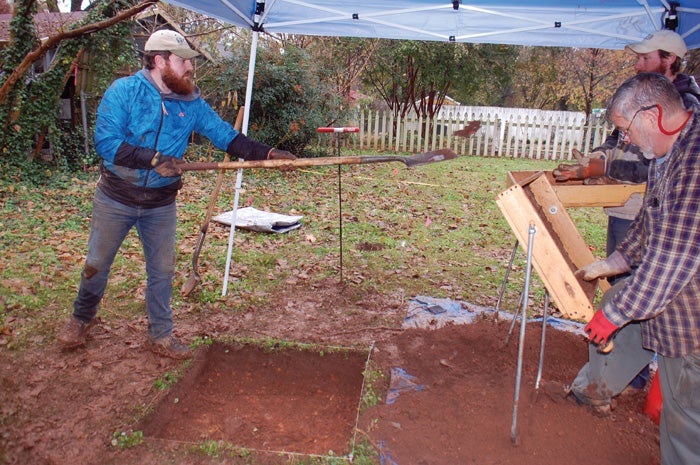Confederate Prison, are you down there?
Published 12:00 am Tuesday, November 13, 2018

- With his shovel, Matt Fuka launches some loose soil from the excavation pit below to field director Nick Arnold. Bob Clarke, foreground, also is sifting soil for the archaelogical crew from Cultural Resource Analysts of Richmond, Va. Working in a private lot off East Bank Street, they are looking for evidence of the Salisbury Confederate Prison's foundation. Mark Wineka/Salisbury Post
SALISBURY — There’s a phrase for what a four-man archaeological crew from Richmond, Virginia, is doing this week at the back of a long, empty lot at 313 E. Bank St.
They call it ground-truthing.
The men from Cultural Resource Analysts are digging several excavation pits — probably as many as six by week’s end — looking for evidence of a stone or brick foundation to the old mill building that served as a barracks for the infamous Salisbury Confederate Prison.
In their initial digs Monday, the CRA team members were enthused by what they were finding, after they dug and sifted through layers of soil representing eras of infill.
“We could quite literally be on top of it,” said Timothy J. Roberts, principal investigator and director of operations for Virginia, as the dig reached some brick and possibly stone and mortar.
The digging started about 8:30 a.m. Monday and represents a joint effort between the city of Salisbury and Historic Salisbury Foundation, owners of the property.
The archaeological research is being paid for with a $10,000 grant that the State Historic Preservation Office awarded to the city. Historic Salisbury Foundation chipped in an additional $7,500.
Steve Cobb, vice president of the HSF board, dropped by the excavation site Monday afternoon to introduce himself and see what was happening. The CRA team, part of a private company, had set up a portable tent over the first excavation pit.
The team dealt with rain and mud throughout its first day. Other members of the team are field director Nick Arnold, Bob Clarke and Matt Fuka.
“We’re getting a lot of material,” Roberts said. “We know that we definitely have artifacts from different eras.”
The initial dig uncovered things such as a Coca-Cola bottle and a modern-day hardware washer. But deeper down, the men were intrigued with the brick they uncovered — and some burnt nails.
Wasn’t the prison burned down by Union forces at the end of the Civil War? they asked.
The archaeological team is using the results of ground-penetrating radar used in 2016 as its road map for where to dig.
A Remote Sensing Laboratory team from the University of North Carolina at Greensboro visited this same site twice in 2016 — on Oct. 30 and Nov. 12.
Members of that team came to Salisbury in late August 2017 to give their report on what the ground-penetrating radar found. They concluded the GPR had located signs of a portico or doorway into the main mill building, which served as barracks on the Confederate Prison grounds.
The signs of construction revealed underneath the surface produced an outline that mimicked the portico on the cotton mill’s north-facing wall (toward present-day East Bank Street).
Historians know that portico to have existed from drawings made of the mill building and Confederate Prison site.
The “ground-truthing” CRA is an effort to investigate deeper and authoritatively report, “This is what we’re seeing, this is the reality,” Roberts said.
The Salisbury Confederate Prison became terribly overcrowded as the Civil War progressed, leading to the deaths of thousands of Union soldiers from disease and starvation. Many of those soldiers were buried in trenches that would become part of Salisbury National Cemetery off Military Avenue in the years after the war.
Virtually all the prisoners were transferred out of the site in February 1865 because of a prisoner exchange program. That didn’t keep Union Gen. George Stoneman from burning down the prison when he arrived in Salisbury in April 1865, right at the war’s end.
Roberts has read some of the history of the prison. Being here in person and working on the East Bank Street site showed him just how close the prison was to the rest of Salisbury.
“It hammers home that this was close to home,” he said. “… Can you imagine how putrid this place would have been with 10,000 poor souls here?”
From Historic Salisbury Foundation’s point of view, one of the best things that could result from the archaeological research is that some of the footprint of the prison might be revealed, leading to an interpretation on the site that people could visit.
“It would be awesome, it really would,” Cobb said.
Only one prison-related building, thought to have been used as a guardhouse, still exists, and it is located along the railroad tracks on the downtown side of the East Bank Street bridge.
The lot at 313 W. Bank St. was donated to Historic Salisbury Foundation several years ago by Jim and Gerry Hurley. The house that stood on the narrow lot burned down in the 1990s.
The archaeological test pits are being dug toward the rear property line, well off East Bank Street.
The expansive prison site spread east of the railroad tracks on both sides of today’s Bank Street and beyond. Through the years after the war, it became a residential area.
Roberts said what he appreciates about working on the HSF site is that it’s no longer threatened by development “and the fact that so many people care about it.”
Contact Mark Wineka at 704-797-4263.


